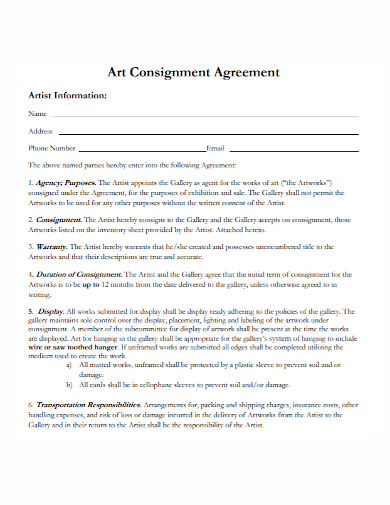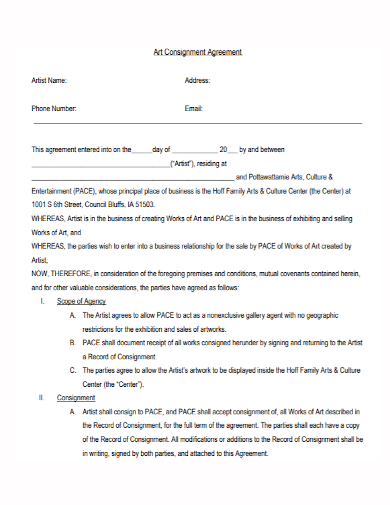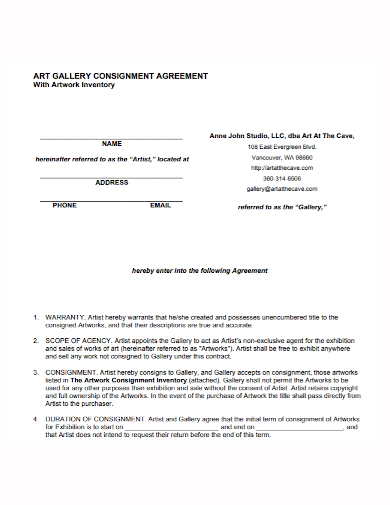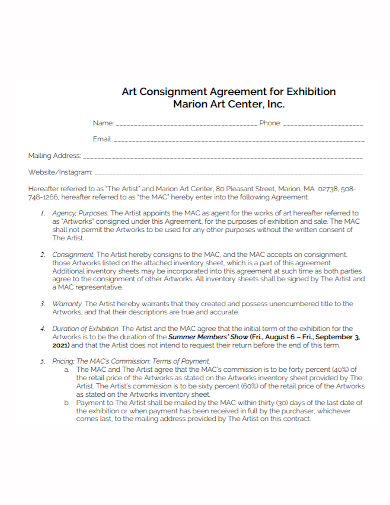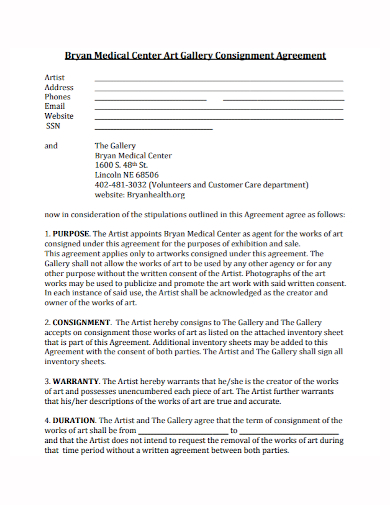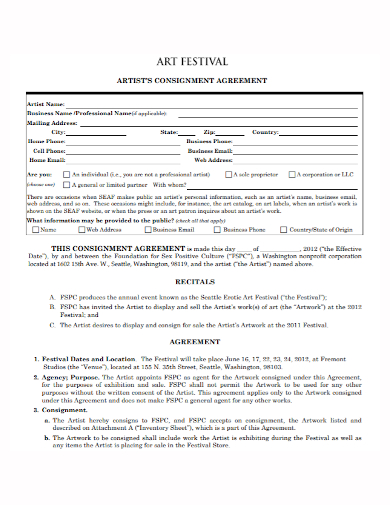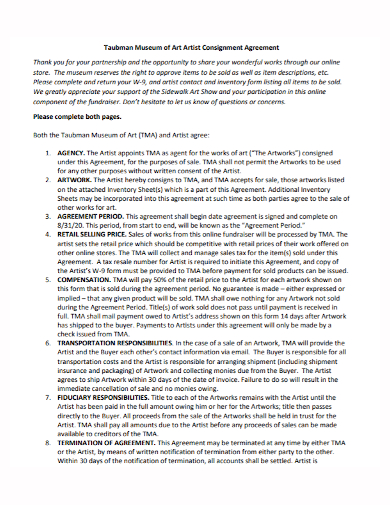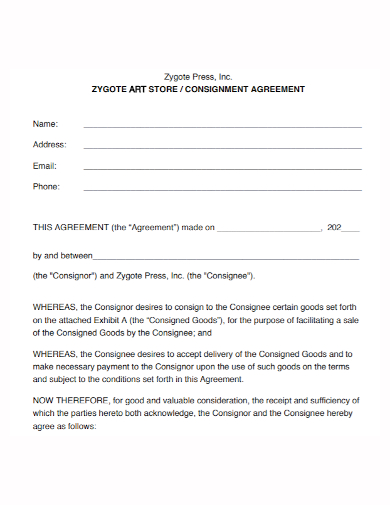When someone in possession of an artwork (usually referred to as “the consignor”) delivers it to a specialized vendor (usually referred to as “the consignee”), it is for the sole purpose of selling it at a later date. To put it another way, you loan a work of art to someone who will try to sell it so you don’t have to deal with it. While it may appear to be a simple process, consigning works of art can become surprisingly complicated and result in a slew of issues. And, believe it or not, the greedy vendors are rarely at the root of these problems, as they frequently do not charge owners for accepting works on consignment.
10+ Art Consignment Agreement Samples
A work of art on consignment is delivered by its owner —the consignor— to a specialist art vendor —the consignee— to be sold at a later date. Art dealers and auction houses are among the vendors. Owners may prefer that the vendor buys the work outright, but the consignment system allows them to benefit from the vendor’s professional services, such as an extensive client list of potential customers and much better publicity and distribution system than they could achieve on their own. Vendors rarely charge owners for accepting works on consignment because they make their money from a commission if the work sells.
1. Art Consignment Agreement
2. Sample Art Consignment Agreement
3. Art Gallery Consignment Agreement
4. Art Exhibition Consignment Agreement
5. Medical Center Art Consignment Agreement
6. Art Festival Consignment Agreement
7. Standard Art Consignment Agreement
8. Basic Art Consignment Agreement
9. Art Artist Consignment Agreement
10. Art Store Consignment Agreement
11. Art House Consignment Agreement
Why People Consign Artworks?
Art consignment was initially developed to accustom non-experts who either inherited a work of art or serve as executors of the estate. In other words, they don’t have the time, desire, or knowledge to properly handle the artwork and would rather send it to someone who can sell it.
Consigning works of art, on the other hand, has become a viable option for anyone looking to sell a work of art without having to haggle with auction houses or art dealers. Art consignment makes a lot of sense in most cases, especially when a consignor needs to liquidate assets as quickly as possible to meet the cash requirements of an estate.
Main Problem with Art Consignment
Consigning artwork can be a convenient way for owners to have their works sold in an efficient and time-effective manner when everything goes according to plan (which it usually does). Things can, however, go horribly wrong at times.
To put it bluntly, if your consigned work does not sell, you will lose all of your money. This means that if you decide to consign something, you must be reasonably confident that it will sell within a reasonable time frame. Otherwise, you could try your luck with an auction house or a dealer of your choice.
The plot thickens further when you realize that galleries are under no obligation to sell the artwork you’ve entrusted them with. They have no financial stake in it, so their desire to find suitors is practically non-existent.
The worst-case scenario is that the vendor keeps the artwork for months, if not years, with no results, before returning it to you. The work is far too overexposed at that point, and it is even less salable than it was when you decided to consign it. It becomes nearly unsellable, and you find yourself in the same predicament you hoped to avoid when you decided to consign it in the first place.
And that’s not the end of the potential issues. While your artwork is on consignment, it may be lost, damaged, or even destroyed. Fortunately for the vendors, most consignment agreements stipulate that the vendor is not responsible for insurance, so keep that in mind as well.
FAQs
What are some of the practical considerations for consignment?
Insist on a well-written consignment agreement that includes your right to sell, a description of the work, the length of the agreement (typically no more than one year, but preferably six months), an agreed-upon sales price, the agreed-upon commission split, when and how payment is to be made, and when the seller is to be notified of a sale.
Why do galleries accept to consign works of art?
The answer is simple: accepting consigned works of art poses no risk to galleries, as they do not invest operating capital in it. Furthermore, because they receive a percentage of the sale, they can afford to offer it at higher and less realistic prices and simply wait for the right buyer. When the new buyer pulls out his checkbook, they’ll get a bigger slice of the pie.
If you want to see more samples and formats, check out some art consignment agreement samples and templates provided in the article for your reference.
Related Posts
FREE 10+ Mentoring Agreement Samples In MS Word | Apple Pages | PDF
FREE 10+ Partner Agreement Samples In MS Word | Google Docs | Apple Pages | PDF
FREE 10+ Individual Agreement Samples In MS Word | Google Docs | Apple Pages | PDF
FREE 10+ Strategic Agreement Samples In MS Word | Google Docs | Apple Pages | PDF
FREE 10+ Equity Agreement Samples In MS Word | Google Docs | Apple Pages | PDF
FREE 10+ Producer Agreement Samples in MS Word | Apple Pages | PDF
FREE 10+ Grant Agreement Samples In MS Word | Apple Pages | PDF
FREE 8+ Meeting Agreement Samples in MS Word | Google Docs | Apple Pages | PDF
FREE 10+ Community Agreement Samples In MS Word | Google Docs | PDF
FREE 8+ Real Estate Option Agreement Samples in MS Word | PDF
FREE 10+ Call Option Agreement Samples In MS Word | PDF
FREE 10+ Advertising Agreement Samples In MS Word | Google Docs | Apple Pages | PDF
FREE 10+ Car Agreement Samples In MS Word | Google Docs | Apple Pages | PDF
FREE 10+ Horse Agreement Samples In MS Word | Apple Pages | PDF
FREE 10+ Option Agreement Samples In MS Word | Google Docs | Apple Pages | PDF

